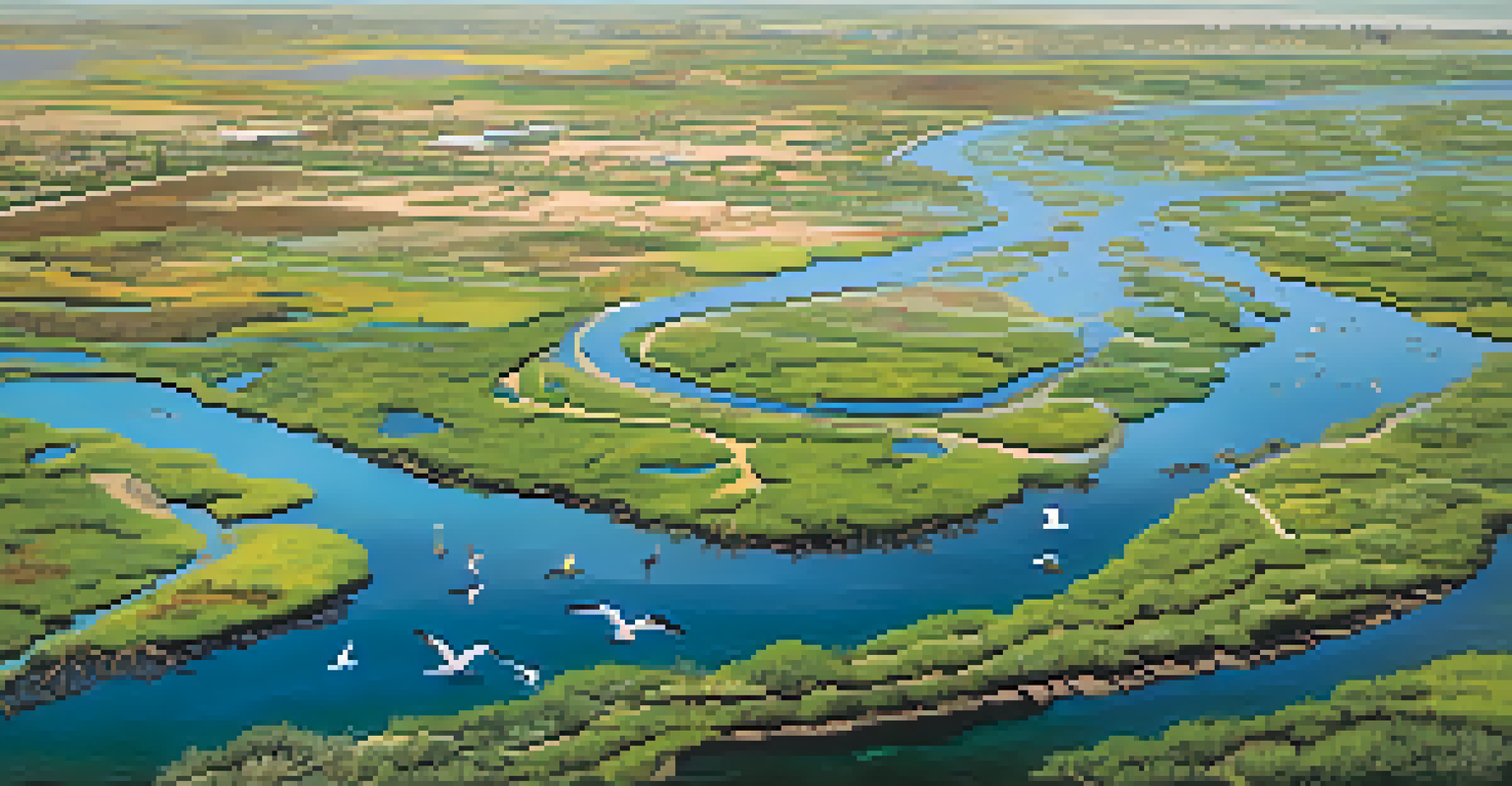Habitat Restoration Projects Along San Diego's Coast

Understanding Habitat Restoration and Its Importance
Habitat restoration refers to the process of returning a degraded ecosystem to a stable, healthy state. In the context of San Diego's coast, this means revitalizing coastal areas that have been affected by human activity and climate change. These efforts are crucial not only for the wildlife that depends on these habitats but also for the communities that enjoy the natural beauty and recreational opportunities these areas provide.
The greatest threat to our planet is the belief that someone else will save it.
San Diego's coastal ecosystems, including wetlands, beaches, and rocky shorelines, face numerous challenges such as pollution, invasive species, and urban development. By restoring these habitats, we can help protect biodiversity, improve water quality, and enhance the resilience of these ecosystems against future environmental changes. Think of it as giving nature a helping hand to bounce back stronger.
Moreover, successful restoration projects often lead to increased community engagement and awareness about the importance of preserving our environment. When people see tangible improvements in their local ecosystems, they are more likely to participate in conservation efforts, fostering a culture of stewardship that benefits everyone.
Key Habitat Restoration Projects in San Diego
Several notable habitat restoration projects are taking place along San Diego's coast, showcasing the collaborative efforts of local organizations, government agencies, and community members. One flagship initiative is the restoration of the San Elijo Lagoon, which has been undergoing significant transformations to improve its ecological health. Through the removal of invasive plant species and the reintroduction of native flora, the lagoon is becoming a thriving habitat for various bird species and marine life.

Another important project is the restoration of the Tijuana Estuary, which aims to enhance wetland habitats while addressing issues like flooding and erosion. This project not only supports wildlife but also provides educational opportunities for visitors, allowing them to learn about the vital role these wetlands play in our ecosystem. It's a great example of how restoration can serve multiple purposes, from conservation to education.
Importance of Habitat Restoration
Restoring coastal ecosystems in San Diego is vital for wildlife, water quality, and community engagement.
Lastly, the ongoing efforts at Mission Bay highlight the importance of community involvement in habitat restoration. Local volunteers regularly participate in beach cleanups and native planting events, helping to restore the natural beauty of the area while fostering a sense of ownership over these precious coastal resources.
Challenges Facing Coastal Habitat Restoration
While habitat restoration projects are essential, they come with their own set of challenges. One major hurdle is securing funding and resources, as these projects often require significant financial investments to be successful. Without adequate funding, plans may stall, and vital ecosystems could remain unprotected, highlighting the need for continued support from both public and private sectors.
We won't have a society if we destroy the environment.
In addition to financial constraints, restoration projects often face bureaucratic hurdles and regulatory challenges. Navigating the complex web of permits and environmental regulations can be a daunting task, which may delay project timelines and increase costs. This underscores the importance of collaboration between stakeholders to streamline processes and ensure that restoration efforts can proceed efficiently.
Lastly, climate change poses an ongoing threat to restoration efforts, as rising sea levels and changing weather patterns can undermine even the best-laid plans. Adaptive management strategies are essential to respond to these changes, ensuring that restoration projects remain effective in the face of evolving environmental conditions.
Community Involvement in Restoration Efforts
Community engagement plays a pivotal role in the success of habitat restoration projects. Local residents, schools, and organizations are often the driving force behind many initiatives, contributing their time and skills to restore their coastal environments. This grassroots involvement not only enhances the projects but also fosters a deeper connection between people and nature.
Educational programs and outreach initiatives help raise awareness about the importance of habitat restoration. By involving youth and community members in hands-on activities, such as planting native species or participating in clean-up events, these programs instill a sense of responsibility and stewardship for the environment. When people understand the impact of their actions, they are more likely to advocate for sustainable practices.
Challenges in Restoration Projects
Habitat restoration efforts face funding, regulatory, and climate change obstacles that require collaborative solutions.
Moreover, community involvement can lead to the identification of local priorities and needs, making restoration projects more relevant and effective. Engaging diverse voices in the planning and execution phases ensures that these initiatives reflect the values and desires of the community, ultimately leading to more successful outcomes.
The Role of Technology in Restoration Projects
Technology has become a valuable ally in habitat restoration efforts along San Diego's coast. Tools like Geographic Information Systems (GIS) and drones help researchers analyze ecosystems, track changes over time, and identify areas most in need of restoration. This data-driven approach allows for more informed decision-making, making projects more efficient and impactful.
Additionally, remote sensing technology can monitor water quality and habitat conditions, providing real-time information that is crucial for timely interventions. For example, if pollution levels rise in a particular area, restoration teams can act quickly to address the issue before it escalates. This proactive approach can save valuable time and resources, ultimately contributing to healthier ecosystems.
Social media and digital platforms also play a role in raising awareness and promoting community involvement. By sharing success stories, volunteer opportunities, and educational content, organizations can engage a broader audience, inspiring more people to take part in habitat restoration and conservation efforts.
Success Stories from San Diego's Coastal Restoration
Throughout San Diego, there are numerous success stories that highlight the positive outcomes of habitat restoration projects. One shining example is the transformation of the San Dieguito River Park, where extensive efforts have led to the revival of native plant species and improved wildlife habitats. This once-degraded area is now a thriving ecosystem, offering recreational opportunities and environmental education to the community.
The restoration of the Bolsa Chica Wetlands is another remarkable success story. Through the removal of invasive species and the reestablishment of native habitats, this area has become a hotspot for birdwatching and environmental education. Visitors can now witness firsthand the benefits of habitat restoration, fostering a greater appreciation for conservation efforts.
Community Engagement Drives Success
Active participation from local residents enhances restoration initiatives and fosters a deeper connection to the environment.
These success stories serve as powerful reminders that restoration is not only possible but also essential for the health of our ecosystems. They inspire hope and motivate communities to continue their efforts, demonstrating that collective action can lead to meaningful change.
The Future of Coastal Habitat Restoration in San Diego
Looking ahead, the future of habitat restoration along San Diego's coast appears promising, thanks to ongoing community engagement and innovative practices. As awareness of environmental issues continues to grow, more individuals and organizations are stepping up to get involved in restoration efforts. This grassroots movement is vital for ensuring the longevity and success of these projects.
Additionally, advancements in technology and research are paving the way for more effective restoration strategies. By incorporating the latest scientific findings and best practices, restoration teams can adapt their approaches to address the unique challenges of each ecosystem. This adaptability is crucial for enhancing resilience against climate change and other environmental stressors.

Ultimately, the success of habitat restoration projects depends on collaboration and a shared commitment to preserving San Diego's coastal environments. By working together—community members, scientists, and policymakers alike—we can create a brighter future for our coastlines, ensuring they thrive for generations to come.